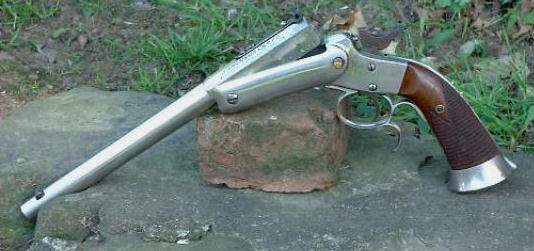

 The Accurate Reloading Forums
The Accurate Reloading Forums  THE ACCURATE RELOADING.COM FORUMS
THE ACCURATE RELOADING.COM FORUMS  Guns, Politics, Gunsmithing & Reloading
Guns, Politics, Gunsmithing & Reloading  Single Shot Pistols
Single Shot Pistols  correcting headspace in a TC - how important?
correcting headspace in a TC - how important?Go  | New  | Find  | Notify  | Tools  | Reply  |  |
| one of us |
Who here has gone through the head space correction procedure as described by Mike Bellm for Thompson Contenders? How much difference will correcting whatever the factory spec is in terms of accuracy? Thanks. | ||
|
| one of us |
If you are interested in getting the absolute top accuracy out of your rig, then it is by all means a critical part of the equation. As an added bonus, your case life will be better as well. I have some 7mm Bullberry brass that has seen more than 2 dozen firings and is still going strong. The loads I shoot are hunting-level and are either a 140 grainer at around 2480 fps or a 130 at 2505 fps from a 20" Contender barrel. (Proper fireforming on the first try is key here too). Bobby Μολὼν λαβέ The most important thing in life is not what we do but how and why we do it. - Nana Mouskouri | |||
|
| One of Us |
The only time I would worry about headspace in a Contender or Encore would be if the firearm wouldn't fire consistently or I was getting head separations prematurely. At least for bottlenecked cases, just neck sizing the fired brass would eliminate most headspace problems. | |||
|
| One of Us |
The Encore, G2, and Contender platforms are not as rigid as a bolt-action. Neck-sizing can eventually (or even rapidly) lead to barrels not locking in place properly. In the Encore/G2, you won't be able to cock the hammer. In the Contender, the hammer won't fall all the way to the firing pin. Determining your barrel-frame gap and then sizing your cases so they protrude from the barrel .001"-.002" less than that gap will provide the most consistency and usually the best accuracy. In the old days, we sized everything so the cases were a "crush" fit, ala Bob Milek. In other words, if you shut the barrel hard enough, the round would fire. Sometimes this worked well, depending on the cartridge. My 7mm-TC/U is a good example of that. I think on larger-diameter, high-pressure (or relatively so, in the case of the G2/Contender) rounds, it becomes more important to size consistently. Accuracy should be good, and case life will be about as long as it can be. Jon Larsson - Hunter - Shooter - Reloader - Mostly in that order... | |||
|
| One of Us |
I neck size routinely in Encores/Contenders and, while occasional full length resizing may be necessary, neck sizing usually works quite well. | |||
|
| One of Us |
On the JDJ 06 based cartridges (60 degree shoulder) I only neck size. Bumping the neck to get the .001 clearance resulted in case seperation after only a few reloads. I have neck sized only my .375 jdj ever since I got it. I never experienced any functional problems. That said, perhaps if I did bump to get the .001 clearance I would improve the accuracy. I do bump my .338 Cooper Express cases to get the .oo1 clearance and it does give me an accuracy advantage over not bumping them. Probably because it's a rimmed case, and if the rim isn't seated accuracy suffers as a result. I never did anything but neck size my .223 cases and was able to get 5/8 inch groups, again maybe I could have improved that if I did bump the shoulder. Just my experiences, like the man said your mileage may differ. | |||
|
| Powered by Social Strata |
| Please Wait. Your request is being processed... |
|
 The Accurate Reloading Forums
The Accurate Reloading Forums  THE ACCURATE RELOADING.COM FORUMS
THE ACCURATE RELOADING.COM FORUMS  Guns, Politics, Gunsmithing & Reloading
Guns, Politics, Gunsmithing & Reloading  Single Shot Pistols
Single Shot Pistols  correcting headspace in a TC - how important?
correcting headspace in a TC - how important?

Visit our on-line store for AR Memorabilia

